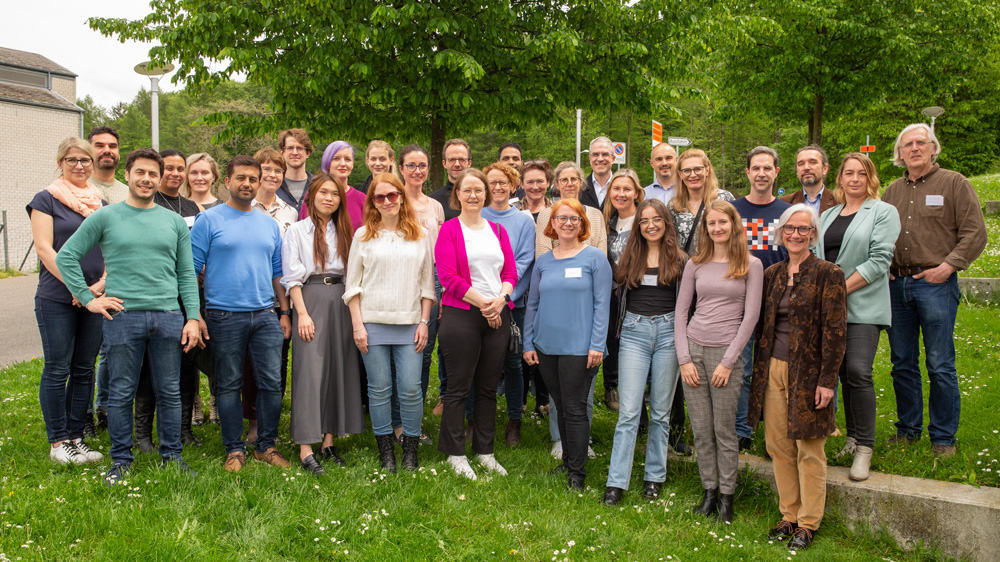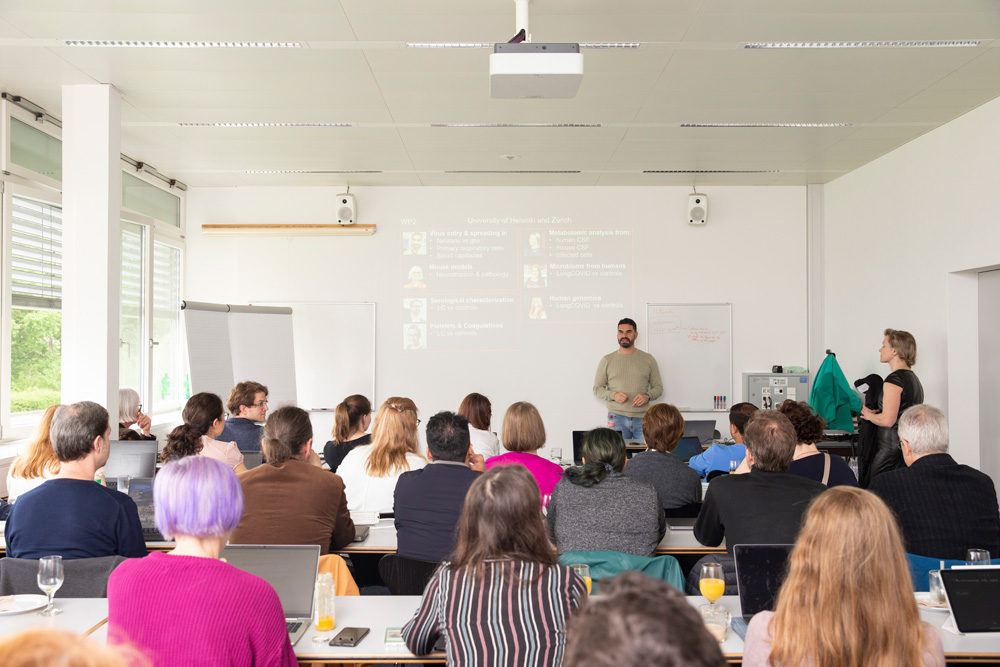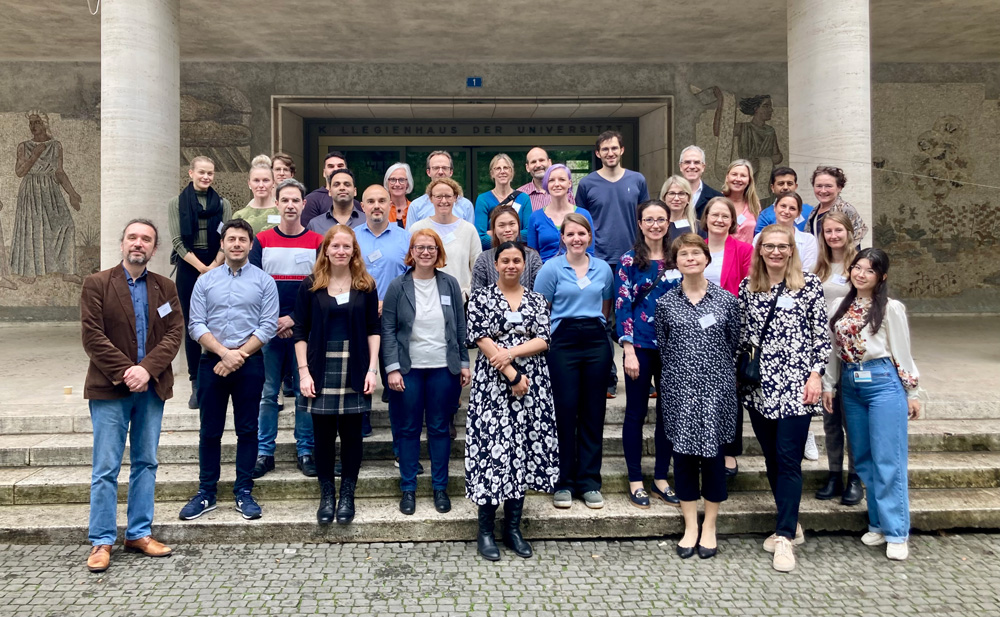|
NEWSLETTER N°1 / May 2023
|
|
|
|
|
|
Welcome to the
1st Long COVID Newsletter!
Since the 1st of June 2022, the Long COVID Consortium, led by HUS Helsinki University Hospital, is working together through nine interconnected work packages (WPs) to elucidate the predisposing factors and mechanisms for the development of Long Covid Syndrome (LCS). It is essential to identify and understand the mechanisms behind the long-term effects of a COVID-19 infection to be able to provide adequate treatment to patients. The research evidence created during the 4-year project will be used to develop and improve the care of Long COVID patients.
|
|
This Newsletter provides an overview of the main progress on the project’s updates for the past months.
|
|

|
|
|
|
|
|
|
|
|
Long COVID cohorts
|
|
|
To decipher the mechanisms underlying LCS, the Long COVID project is conducting geographically diverse cohort and registry studies in Finland, the Netherlands and Switzerland. The main goal of these studies is to collect and analyse clinical characteristics, prognosis, incidence, and healthcare burden of LCS. The Long COVID project gathers information from Long COVID patients in six different cohorts. The selected cohorts can be found on the below:
|
|
|
|
- -
- Finland
- Cohort 1 – Registry linkage cohort from the Finnish National Centre for Health and Welfare (NCHW)
- Cohort 2 - LC policlinic - HUS
- Cohort 3 – ClinCOVID Cohort – University of Helsinki (UH)
- Cohort 4 – ICU Cohort –UH
- -
- -
- The Netherlands
- Cohort 5 – Lifelines /
Dutch population cohort – UMCG
- -
|
|
There are currently 370 patients in the cohorts in Finland. Many of them have already given samples for biomechanism studies. Additionally, information on the recovery from Long COVID is gathered as well. In the Netherlands, 140 patients from the Lifelines cohort participate in the study and have been investigated thoroughly, e.g., clinical physiology testing. In Switzerland, the cohort study is planned and ready to start recruiting the 120 aimed patients from May 2023 on.
|
|
The cohort and clinical studies are conducted at Helsinki University Hospital (HUS, coordinator and WP1 “LCS cohorts and guidelines” leader), University Hospital Basel (USB), and the University Medical Centre Groningen (UMCG).
|
|
In 2023, the first biomechanism analyses from the cohort patients will be performed. Results on the prognosis of Long COVID patients have been analysed and will be soon sent for peer review.
|
|
|
|
|
|
|
Mechanistics and
pathogenic studies
|
|
|
The WP2, led by UH, has 3 main goals:
|
- Characterise the range of antibodies produced by Long COVID patients not only against the viral spike proteins but against the full spectrum of viral proteins;
- Characterise the key changes in metabolic fluxes and gut microbiome that occur in Long COVID patients compared to controls;
- Understand the mechanisms of virus infection in the brain, determine how long a brain infection can persist, and what are the consequences of brain infection.
|
|
|
|
|
|
One year after the start of the project, WP2 has established all the procedures for addressing the first two aims and samples are being collected from Long COVID patients and control individuals.
|
|
|
For the third aim, thanks to robotised tech-nologies and state-of-the-art approaches to reprogram human stem cells into fully differentiated neurons and other brain cells, we have already discovered the main mechanism of SARS-CoV-2 neuronal infec-tion. We found that even if brain cells express very low levels of the viral receptor, a cellular protein called ACE2 that is very abundant in the respiratory tissues, SARS-CoV-2 can infect and multiply in human neurons.
|
|
|
Our → first study shows that the virus first binds to the ACE2 receptor on the surface of neurons, and after being ‘swallowed’ by the cell, the viral particles are transported into the digestive organelles called lysosomes. Similarly, to our stomach, the lysosomes are full of digestive enzymes. It is thanks to these enzymes and their action that the virus is able to escape from the lysosomes and enter the cell environment where the multiplication and assembly of new progeny virions occurs. By inhibiting pharmacologically, the transport of viral particles from the surface of the cell into the digestive lysosomes, we were able to efficiently prevent neuronal infection [ → read more ].
|
|
|
|
|
|
|
The consequences of neuronal infection include a loss of neuronal function, with progressive retraction of axons. In addition, a collaborative effort with the University of Queensland (Australia) let to an unexpected discovery: infected neurons can fuse with the neighbouring cells, a process known as syncytia formation and already observed in the lung cells but never in neurons [ → read more ]. What happens when two neurons are fused together? The study shows that neuronal function after cell-to-cell fusion is compromised. If this phenomenon occurs in humans, where brain infection by SARS-CoV-2 has already been documented, the main neurological symptoms of Long COVID could be explained.
|
|

|
|
WP2 is now continuing its work on brain infection trying to understand on the one hand how long can a brain infection last and, on the other, can the immune system resolve a brain infection? If so, what are the long-term neurological consequences of such a transient infection? Our goal is to find an explanation for the long-lasting symptoms of Long COVID and to find treatments that can prevent or cure the disease.
|
|
|
|
|
Biomarker prediction and
patient stratification
|
|
This specific WP (WP5 led by partner NEC) aims at using Artificial Intelligent(AI)-based models to merge the different information & data of the Long COVID patients (genomics, proteomics, questionnaires, EHR) coming from different WPs to both predict the occurrence of the LCS and to detect novel biomarkers that will help in its detection.
|
|
During this first year, the focus has been more on data generation and gathering, for which several meetings were conducted together with the clinical partners (e.g. HUS, UH, Protobios) and NUROMEDIA (WP6 leader), in order to discuss the data format and how they will be pre-processed in order to be ready to be given to the future AI model.
|
|
|
|
|
Said model will start being actively developed during the second year, in which the main aim will be to exploit NEC’s Graph-based AI solution for an intelligent combination of the different data modalities. Currently, the blueprint of the model has already been already decided and will be tested as soon as the data from the corresponding WPs (WP1 to WP4) becomes available.
|
|
|
|
|
Data Portal
|
One of the main objectives of the Long COVID project is the establishment of the open-access Long COVID Data Portal to collect the data for Long COVID Syndrome research, from the project but also from external sources. The Data Portal will include novel methods for harmonising and accessing integrated data for distributed data analyses, and a Static and Interactive graphic user interface infographic for patients, clinicians, and researchers.
|
|
One of the major achievements during the project’s first year was the development and successful implementation of the user-friendly Long COVID Data Portal. Partner NUROMEDIA (NURO, WP6 “Data Infrastructure, processing & GUI” leader), responsible for this task, evaluated heuristically and through cognitive walkthroughs with small multidisciplinary end-users groups the prototype of the Data Portal. The objective was to review and specify the main elements of the data infrastructure frames, the required communication standards, the appropriate security, as well as data privacy measures.
|
|
|
|
NURO is following the agile, iterative development strategy and it allows them to update continuously the interfaces and the available functionalities from the Long COVID Data Portal.
|
The next steps are focused on developing and integrating visualisation and analysis interfaces of the complex COVID-related data sets. NURO installed and is currently testing a couple of data visualisation tools and solutions all with their specific strengths and weaknesses.
|
|
Project partners are regularly informed about the available data visualisation instruments and tools. All are currently accessible through secure web interfaces for testing and initial feedback collection. The preliminary results are already available, and all are mostly related to the needs of end-users to be provided with simple and intuitive interfaces which would not require advanced IT skills.
|
|
|
|
|
Ethics and privacy
|
|
Within the Long COVID project, partner Chino is the leader of WP7 “Ethics and privacy”. The main objectives of WP7 are: (1) Ethics – This consortium will invest significant effort to ensure all AI-based decision support developed in the project are ethical and trustworthy, this is especially important with AI and medical ethics that are based on the principle of “primum non nocere”—first, do no harm, (2) General Data Protection Regulations (GDPR) compliance – Need to demonstrate how the architecture developed is completely compliant with GDPR and that data is stored in a suitably robust manner, and Data security – Need to assure the data are managed in respect of the privacy regulations and security best practices.
|
|
|
Chino worked in this first year with all the partners to define the proper agreements between them to share data. This is a fundamental part requested by the GDPR, as when two or more parties share personal data, they must sign an agreement to make sure each party handles the personal data properly. After that, any activity of data processing inside the project can start.
|
As a result of the activities of the WP7, a Joint Controllership Agreement (JCA) has been signed by all the partners involved with data sharing inside the Long COVID project and a Data Processing Agreement (DPA) with the technical partner responsible for Data Infrastructure, processing and data portal of the project.
|
|
Chino also took care of the ethical aspects of the project. For that purpose, it has created an Ethical Advisory Board composed of three experts. In the next few weeks, Chino will share with the partners the Ethics guidelines to be followed during the implementation of the project. Specific support will be given to all the partners at any time, to assure we can deliver an ethical project.
|
|
|
|
|
|
|
Long COVID project website & social media
|
|
Launched on November 2022, the → Long COVID website , with a simple interface easy to use, includes several functionalities, tools and features to ensure the highest extent of accessibility for all types of relevant stakeholders (e.g. scientific community, policy makers and general public). Goetzinger+Komplizen, a German design agency also responsible for the project’s visual identity, designed the project website under the guidance of SEZ to communicate, inform and promote the use of project results among the target audiences. The project website brings together general information about the project, the latest news and events, networking activities, publications, public deliverables and social media.
|
|
|
|
|
Nowadays, developing a strategy for social network and social media is crucial as most of the actors in the health and scientific fields, the media and the general public are using such media. This can be explained by the necessity to get and receive the information as fast and as simply as possible. Social Media also tends to enhance a more concrete level of exchange than a simple website, giving an impression of proximity. Currently, the project has two social media: the Long COVID LinkedIn account launched on July 2022 (789 followers), and the Long COVID Twitter account launched on November 2022 (234 followers).
|
|
|
Furthermore, different communication materials (e.g. Long COVID flyer, Long COVID roll-up) were developed to increase the visibility of the project. All these materials are publicly available in the Communication material section on the project’s website.
|
|
|
|
|
|
|
|
Long COVID has already established contact with relevant identified European projects and initiatives dealing with Long COVID to discuss potential collaborations but also to support each other to increase the visibility of the projects/initiatives (own websites, social media) and the dissemination of their findings and results (e.g. joint webinars and workshops). Furthermore, if needed, these projects/initiatives will be consulted to validate specific Long COVID approaches and/or findings and discuss the exploitation of the results.
|
|
|
As a fundamental target group, the Long COVID patient perspective is essential for the successful implementation of the Long COVID project, for that reason, the project is in contact with, for example, the European ME Coalition, an advocacy group for persons suffering from Myalgic Encephalo-myelitis/Chronic Fatigue Syndrome (ME/CFS, illness consequence of a viral infection with symptoms similar to Long COVID) in Europe.
|
|
The Long COVID Project had the opportunity to meet with representatives from Long COVID Europe, the European network of Long COVID patient organisations, and its member, Long COVID Deutschland. During this meeting, Mari Kanerva (Long COVID co-coordinator, HUS) presented an overview of the main actions and objectives of the project, followed by a very fruitful and interesting exchange between the project and the two organisations. Especially interesting were the suggestions on how to improve the clinical questionnaires to be filled out by the Long COVID patients within the project and the recommendations to successfully engage Long COVID patients with the project.
|
|
At the European project level, Long COVID has actively supported the dissemination of findings and results of the recently finished COVIRNA project. Furthermore, the project is currently discussing potential communication and dissemination collaborations with the ongoing Horizon Europa ORCHESTRA cohort project.
|
|
|
|
|
|
Long COVID
Consortium Meeting
in Switzerland
|
|

|
|
After one year of its official beginning, the Long COVID project held its 12-month Consortium Meeting in Basel & Zurich, Switzerland. During these two days meeting, all partners discussed the progress and findings of each work package, as well as the next steps and upcoming actions. Among other topics, the promising results of the studies on the interaction of SARC-CoV-2 with neurons using cell- and mouse models were presented, as well as the development of the Artificial Intelligence prediction tool for Long COVID.
|
|
|
|
|
Thank you very much to our two Swiss partners for hosting the consortium meeting at the University of Basel on the first day, and the second one at the University of Zurich. Additionally, during these two days, the Long COVID consortium had the opportunity to visit Basel Long COVID Clinic (University of Basel) and the laboratory for Animal Model Pathology (the Institute of Veterinary Pathology (IVPZ)) at the University of Zurich.
|
|

|
|
|
|
Project Coordinator-Support
Riikka Paasikivi
|
Communication & Dissemination leader
Francisco Javier Casado Hebrard
|
|
|
|
|
|

|
|
Funded by the European Union. Views and opinions expressed are however those of the author(s) only and do not necessarily reflect those of the European Union or the European Health and Digital Executive Agency (HaDEA). Neither the European Union nor HaDEA can be held responsible for them.
|
|
|
|
 
|
|
|
|
|
|
|
|